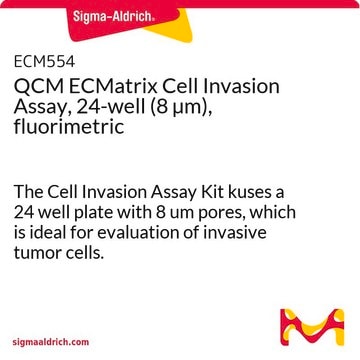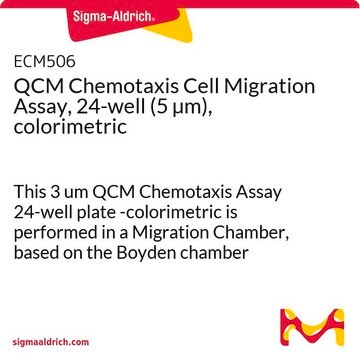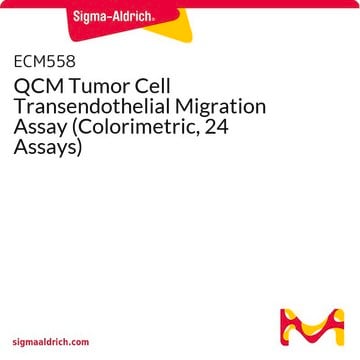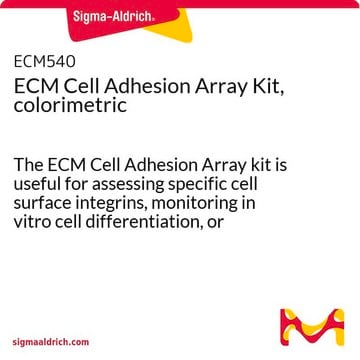ECM210
QCM Endothelial Cell Invasion Assay (24 well, colorimetric)
This QCM Endothelial Cell Invasion Assay provides an in vitro model to quickly screen factors that can regulate endothelial invasion. The assay is performed in an invasion chamber using a basement membrane protein coated on the porous insert.
About This Item
Produits recommandés
Niveau de qualité
Fabricant/nom de marque
Chemicon®
QCM
Technique(s)
cell based assay: suitable
Méthode de détection
colorimetric
Conditions d'expédition
wet ice
Description générale
Introduction
Endothelial cells (EC) invade through the basement membrane (BM) to form sprouting vessels. The invasion process consists of the secretion of matrix metalloproteases (MMP) to degrade basement membrane, the activation of endothelial cells, and the migration of EC across the basement membrane. The understanding of EC invasion is important for studying the mechanism of angiogenesis in injured tissue as well as in disease such as cancer.
Cell migration may be evaluated through several different methods, the most widely accepted of which is the Boyden Chamber assay. The Boyden Chamber system uses two-chamber system which a porous membrane provides an interface between two chambers. Cells are seeded in the upper chamber and chemoattractants placed in the lower chamber. Cells in the upper chamber migrate toward the chemoattractants by passing through the porous membrane to the lower chamber. Migratory cells are then stained and quantified.
Application
Apoptosis & Cancer
Cell Structure
Conditionnement
Composants
2. Cell Stain Solution: (Part No. 90144)* One bottle.
3. Extraction Buffer: (Part No. 90145) One bottle.
4. 24-well Stain Extraction Plate: (Part No. 2005871) One each.
4. 24-well Stain Extraction Plate: (Part No. 2005871) One each.
5. 96-well Stain Quantitation Plate: (Part No. 2005870) One each.
6. Cotton Swabs: (Part No. 10202) Fifty each.
7. Forceps: (Part No. 10203) One each.
Stockage et stabilité
Informations légales
Clause de non-responsabilité
Mention d'avertissement
Danger
Mentions de danger
Conseils de prudence
Classification des risques
Eye Irrit. 2 - Flam. Liq. 2
Code de la classe de stockage
3 - Flammable liquids
Point d'éclair (°F)
53.6 °F
Point d'éclair (°C)
12 °C
Certificats d'analyse (COA)
Recherchez un Certificats d'analyse (COA) en saisissant le numéro de lot du produit. Les numéros de lot figurent sur l'étiquette du produit après les mots "Lot" ou "Batch".
Déjà en possession de ce produit ?
Retrouvez la documentation relative aux produits que vous avez récemment achetés dans la Bibliothèque de documents.
Les clients ont également consulté
Articles
Cell based angiogenesis assays to analyze new blood vessel formation for applications of cancer research, tissue regeneration and vascular biology.
Notre équipe de scientifiques dispose d'une expérience dans tous les secteurs de la recherche, notamment en sciences de la vie, science des matériaux, synthèse chimique, chromatographie, analyse et dans de nombreux autres domaines..
Contacter notre Service technique












